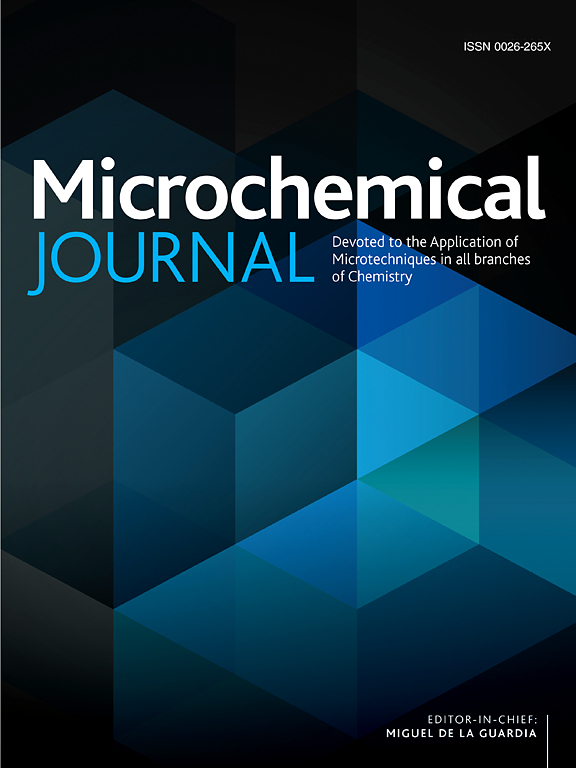基于锆-四苯基卟啉四磺酸水合金属有机骨架与铜离子配位的比例比色大肠杆菌检测传感器
IF 4.9
2区 化学
Q1 CHEMISTRY, ANALYTICAL
引用次数: 0
摘要
大肠杆菌(大肠杆菌)是最普遍的食源性病原体之一,释放有毒物质并引起传染性和危及生命的疾病。因此,快速、灵敏地检测大肠杆菌对保障人类健康至关重要。本文利用锆(Zr)-四苯基卟啉四磺酸(TPPS)水合金属有机框架(Zr- tms)和铜离子(Cu2+)之间的配位,构建了用于检测大肠杆菌的比例比色传感器。大肠杆菌可以通过其独特的代谢活动捕获外部Cu2+并将其转化为Cu+。这种能力进一步增强了zr - tm中卟啉配体与金属离子之间的配位相互作用。结果表明,Zr-TMs的紫外-可见吸收光谱性质发生了变化,在413 nm处(A413)的吸收峰增强,在434 nm处(A434)的吸收峰减弱。该传感器通过监测A413与A434比值的增加,在63 min内快速灵敏地检测出浓度为102 ~ 107 CFU/mL的大肠杆菌,检出限为19 CFU/mL。溶液的颜色逐渐由绿色变为无色。该方法利用了Zr-TMs探针产生的两个紫外-可见吸收峰信号(A413和A434)的相反变化,提高了检测精度,实现了可视化分析。此外,该方法准确地鉴定出牛奶样品中的大肠杆菌,显示出检测食品中致病菌的巨大潜力。本文章由计算机程序翻译,如有差异,请以英文原文为准。
A ratiometric colorimetric sensor for Escherichia coli detection based on the coordination between zirconium-tetraphenylporphyrin tetrasulfonic acid hydrate metal–organic frameworks and copper ions
Escherichia coli (E. coli) is one of the most prevalent foodborne pathogens, releasing toxic substances and causing infectious and life-threatening diseases. Thus, the rapid and sensitive detection of E. coli is essential for safeguarding human health. Herein, a ratiometric colorimetric sensor was constructed for detecting E. coli, utilizing the coordination between zirconium (Zr)-tetraphenylporphyrin tetrasulfonic acid (TPPS) hydrate metal–organic frameworks (Zr-TMs) and copper ions (Cu2+). E. coli can capture and convert external Cu2+ into Cu+ through its distinctive metabolic activities. This capability further enhances the coordination interaction between the porphyrin ligands in Zr-TMs and the metal ions. As a result, the ultraviolet–visible (UV–vis) absorption spectral properties of Zr-TMs changed, exhibiting an enhanced absorption peak at 413 nm (A413) and a weakened peak at 434 nm (A434). By monitoring the increase in ratio of A413 to A434, this sensor achieved rapid and sensitive detection of E. coli at concentrations ranging from 102 to 107 CFU/mL within 63 min, with a detection limit of 19 CFU/mL. The color of the solution gradually changed from green to colorless. This proposed ratiometric method utilized the opposite changes in the two UV–vis absorption peak signals (A413 and A434) generated by the Zr-TMs probes, improving detection accuracy and achieving visual analysis. Additionally, this method accurately identified E. coli in milk samples, demonstrating substantial potential for detecting pathogenic bacteria in food.
求助全文
通过发布文献求助,成功后即可免费获取论文全文。
去求助
来源期刊

Microchemical Journal
化学-分析化学
CiteScore
8.70
自引率
8.30%
发文量
1131
审稿时长
1.9 months
期刊介绍:
The Microchemical Journal is a peer reviewed journal devoted to all aspects and phases of analytical chemistry and chemical analysis. The Microchemical Journal publishes articles which are at the forefront of modern analytical chemistry and cover innovations in the techniques to the finest possible limits. This includes fundamental aspects, instrumentation, new developments, innovative and novel methods and applications including environmental and clinical field.
Traditional classical analytical methods such as spectrophotometry and titrimetry as well as established instrumentation methods such as flame and graphite furnace atomic absorption spectrometry, gas chromatography, and modified glassy or carbon electrode electrochemical methods will be considered, provided they show significant improvements and novelty compared to the established methods.
 求助内容:
求助内容: 应助结果提醒方式:
应助结果提醒方式:


